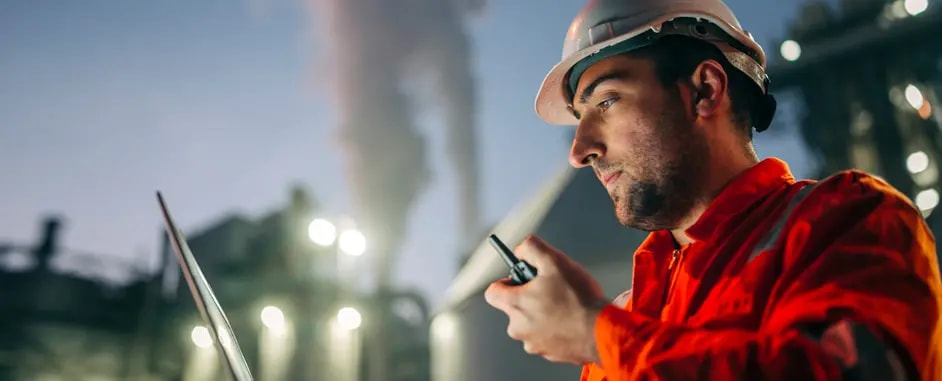Protect and support lone workers in remote or hazardous environments

Improving worker safety is a mission-critical objective for every manufacturer, but especially those with workers who must complete tasks on their own. Manufacturers must be able to guarantee operational awareness and support for any situation lone workers might encounter. At the same, workers must feel supported and protected no matter where they’re working or which task they’re executing.
On many industrial campuses today, it’s easy for workers to be out of reach of both corporate Wi-Fi and commercial cellular networks. These connectivity gaps make it extremely difficult to introduce critical worker-safety initiatives. The good news is, technologies available today are changing this story to dramatically improve safety for lone workers before, during and after incidents.
Always-on wireless connectivity and team communications keep workers connected
The first step in better protecting lone workers is to provide pervasive, industrial-grade connectivity indoors and outdoors across your manufacturing campus. With instant access to secure and reliable 4G/5G private wireless connectivity campus-wide, no worker is ever truly alone.
As long as an injury or environmental hazard doesn’t prevent workers from communicating, they’re always reachable by two-way voice, video and data communications using ruggedized handheld devices. Workers can get in touch with colleagues and remote experts to advise of job completion delays, report potential safety issues and alert them about safety incidents.
Intelligent apps automatically monitor lone worker safety
But what if a lone worker is unable to communicate? This is where solutions that are purpose-built to automatically monitor and report on changes to a worker’s situation are invaluable:
- If a worker falls, their industrial mobile device gyro sensors can detect the fall and the shock, and a “man down” alert can be sent together with their location and identifies the closest worker that can come and help. If the worker was wearing a connected hard hat, shock sensor in the worker’s hard hat can also notifies the system the strength of the shock to the head, so that responders are aware there’s a potential head injury.
- If a worker becomes immobile for any reason for a given time, a “no movement” alert indicates that a physical impediment or environmental hazard may be present.
The same solution also allows lone workers to regularly check in and confirm their safety, with programmed regular button press on their phones.
Solutions that help to avoid collisions are also key to protecting lone workers, in area with lots of moving vehicles (ports straddle carriers, factory forklift trucks, etc…) and especially as industrials increasingly rely on automated and autonomous vehicles. These solutions use proximity sensors or video analytics from camera to detect nearby moving equipment and automatically initiate visual and audible alerts to warn workers of the impending risk of collision.
Geofencing solutions let you create virtual boundaries around hazardous areas so you’re always aware when a worker is in a higher risk environment. When a worker crosses the boundary, a photo is automatically taken and sent along with location information to the plant monitoring center. The worker also receives an alert and a report of the geofence trigger on their smartphone to ensure they know they’ve crossed a virtual safety boundary.
Drones accelerate visibility and response times
Once you’re aware of an incident, drones let you quickly and safely provide first response assessment of the severity of a situation and initialize emergency support without endangering other workers. With Drone as First Responder (DFR) capabilities, you can immediately dispatch one or more unmanned aerial vehicles (UAVs) to the scene. HD cameras with thermal sensing technologies, or additional sensors (gaz, etc...) provide real-time insights that allow ground teams to make informed decisions before they reach the incident location.
Give lone workers the safety support they need
The Nokia one platform for industrial digitalization provides all of the technologies you need to make these worker safety enhancements a reality. All platform components — connectivity, edge computing, applications, and industrial-grade devices — are delivered as a service to simplify your evolution and accelerate your overall transformation to Industry 4.0.
Key platform components to achieve the safety enhancements described above include:
- Nokia Team Comms, an application that delivers mission-critical push-to-voice, video and data communications with no internet connection required.
- Portalify SmartView, enables lone workers to check in regularly and push out alerts to request help in an emergency situation. Man-down technology detects worker movement, monitors their locations and smartphone connectivity, and collects other relevant data in the case of emergency.
- Ascom Ofelia, an alarm and workflow management suite that simplifies alerting and provides new visibility into workplace operations to enhance situational awareness.
- Nokia ruggedized industrial devices, including handhelds that are Ex-certified for use in hazardous atmospheres.
- Nokia Drone Networks, a complete and fully automated UAV solution for industrial worker safety.
- Nokia Visual Position and Object Detection, use existing cameras to track the position of people and assets to improve visibility, identify potential hazards and accelerate responses.
Step into the new era of worker safety in manufacturing
To learn more about taking your worker safety strategy to the next level, visit dac.nokia.com/industry/worker-safety or contact us today.




